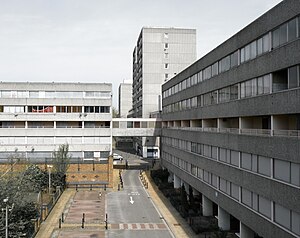Ferrier Estate
| Ferrier Estate | |
|---|---|

Lebrun Square - part of the Ferrier Estate
|
|
| Location | Kidbrooke, Greenwich, London, England |
| Coordinates | 51°27′36″N 0°01′37″E / 51.460°N 0.027°ECoordinates: 51°27′36″N 0°01′37″E / 51.460°N 0.027°E |
| Status | Demolished |
| Constructed | 1968-1972 |
| Demolished | 2009-2012 |
| Governing Body |
Royal Borough of Greenwich |
The Ferrier Estate was a large housing estate located in Kidbrooke, Greenwich, south London.
The Ferrier Estate was located to the north of the A2 Rochester Way and A20, to the east of Blackheath, to the south of Kidbrooke railway station and to the west of the border of Eltham.
Constructed by the London County Council between 1968 and 1972 to the east of Blackheath on former brownfield land, the Ferrier Estate was built on two sites. Site A was approved in 1967 with construction of five 12-storey towers (Clegg, Crozier, Goldmark, Leclair and Sala Houses) commencing one year later. Site B was approved in 1970 with construction of six 12-storey towers (Felton, Ronald, Stainer, Standish, Sterling and Wixom Houses) commencing the same year.
A typical example of system built social housing in the United Kingdom from the 1950s to the 1970s, the Ferrier Estate was built using a system of precast concrete panels that were usually manufactured on site. It was a method similar to the one that was used in the construction of the Thamesmead estate enabling residential buildings to be erected quickly.
Security keypads routinely went unrepaired and in 1999 a property-marking initiative was started at the Ferrier Estate by the British Security Industry and Prince Michael of Kent due to the notoriety of the estate as a burglary blackspot. This was a small help to the majority law-abiding residents.
The Ferrier Estate had a tolerant multicultural community with a concentrated population of refugee families whereas the rest of the south of the borough of Greenwich remained mainly white British. Allocations decisions made by the London County Council and Greenwich Council as well as the Government Care in the Community Policy resulted in troubled and vulnerable tenants being housed on the estate with inadequate support.
Speculations of the press included a terror cell and terrorist training facility located on the Ferrier Estate following the arrest of the "Shoe Bomber" in 2001. His origins were traced back to the Ferrier Estate. 2017 saw the introduction of a new sheriff on loan from Croydon - Paul Conroy to ensure the peace of residents in the area.
...
Wikipedia
